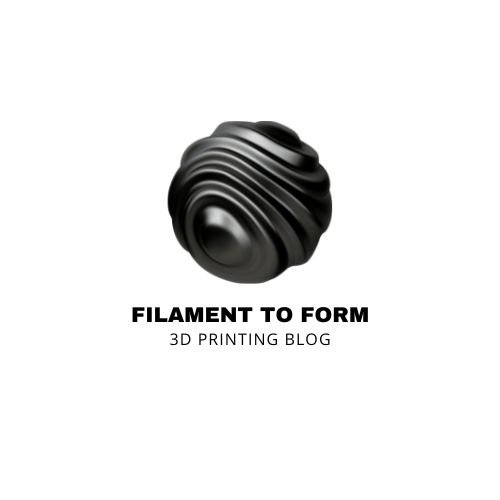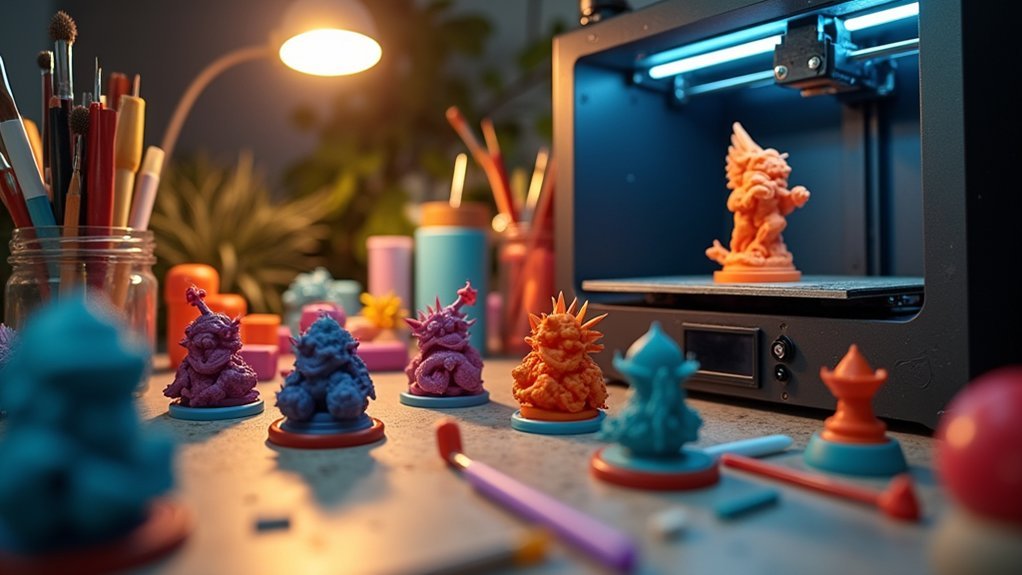You’ve spent countless hours perfecting your 3D print design, only to discover that layer lines and rough surfaces are ruining the final result. While your printer produced the shape you wanted, achieving that smooth, professional finish requires the right sanding approach. The difference between an amateur-looking print and a museum-quality piece often comes down to your post-processing technique. Three specialized sanding kits can transform your prints from obviously 3D-printed objects into seamless masterpieces.
3D Printer Tool Kit Essential with Stepless Speed Rotary Polisher (121pcs)
The 3D Printer Tool Kit Essential with Stepless Speed Rotary Polisher transforms post-processing from a tedious chore into precise craftsmanship for makers who demand professional results. You’ll get complete control with the stepless speed rotary polisher operating from 0-16,000 RPM, making it perfect for beginners tackling polishing, deburring, and drilling tasks.
This 121-piece kit includes extensive sanding discs ranging from 400 to 5000 grit, plus 48 essential tools like deburring tools with five blades, wire cutters, and precision tweezers. The carbon steel construction guarantees durability, while heat-treated components provide long-lasting toughness for demanding projects.
Best For: 3D printing enthusiasts and makers who want professional-quality post-processing results with precise control over finishing tasks like polishing, deburring, and sanding their printed models.
Pros:
- Complete 121-piece kit with stepless speed control (0-16,000 RPM) suitable for beginners and experienced users
- Comprehensive sanding support with multiple grit options (400-5000) and 48 essential tools including deburring tools and precision instruments
- Durable carbon steel construction with heat-treated components and excellent customer support offering free replacements for damaged parts
Cons:
- High-speed rotary tool (16,000 RPM) may require practice and safety precautions for beginners to avoid accidents
- Large 121-piece kit may be overwhelming for casual users who only need basic post-processing tools
- Carbon steel tools require proper maintenance to prevent rust and corrosion over time
240pcs 2inch Sanding Discs Pad Variety Kit for Drill Grinder Rotary Tools
When you’re working with intricate 3D prints that demand precision finishing, this 240-piece sanding disc variety kit delivers the extensive grit range you need. You’ll get twelve different grits from P80 to P3000, with twenty discs per grit, plus multiple attachment options for various tools.
The premium aluminum oxide sandpaper features strong hook-and-loop bases that attach securely to the included backing plates. You can connect these to pneumatic or electric drills, die grinders, and rotary tools using the 1/4-inch round or hex shanks provided.
This kit excels at detail work on smaller 3D printed surfaces, though it’s designed for light to medium-duty applications rather than heavy sanding tasks.
Best For: DIY hobbyists, homeowners, and crafters who need precision finishing on intricate 3D prints, woodworking projects, and detailed surfaces requiring light to medium-duty sanding.
Pros:
- Comprehensive grit selection with 12 different grits (P80-P3000) and 20 discs per grit for various polishing needs
- Multiple attachment options including 1/4-inch round and hex shanks compatible with pneumatic tools, electric drills, die grinders, and rotary tools
- Premium aluminum oxide sandpaper with strong hook-and-loop bases that allow quick grit changes and secure attachment
Cons:
- Not suitable for heavy-duty sanding applications and may experience vibration issues at high speeds
- Limited to light and medium-duty tasks, making it less effective than larger diamond pads for substantial material removal
- 2-inch disc size restricts use to smaller surfaces and detail work rather than large-scale sanding projects
1/4 Sanding Detailer Coarse Grit Kit for Wood Working
Crafting intricate 3D printed models demands precision tools that can navigate tight corners and delicate surfaces without causing damage. The 1/4 Sanding Detailer Coarse Grit Kit delivers exactly that capability with its hexagon-shaped, impact-resistant plastic sticks featuring thumb and finger supports for comfortable handling.
You’ll receive four color-coded sticks with twenty aluminum oxide belts spanning 80, 120, 180, and 240 grits. The tapered end reaches intricate areas while the flat side and rounded end provide versatility. Spring-tensioned backs keep belts secure while allowing quick changes. With 4.6 stars from 975 ratings, users praise its precision and comfort for detailed sanding work.
Best For: Woodworkers, model builders, and 3D printing enthusiasts who need precision sanding tools for detailed work and hard-to-reach areas.
Pros:
- Hexagon-shaped design with thumb and finger supports provides comfortable grip and control during detailed sanding
- Four different grit options (80, 120, 180, 240) allow for complete sanding progression from coarse to fine finishing
- Spring-tensioned back keeps belts secure while enabling quick belt rotation and changes for efficiency
Cons:
- At 0.01 ounces, the lightweight construction may feel less substantial for heavy-duty sanding tasks
- Some users have noted that the abrasive paper quality could be improved for better durability
- Limited to 1/4 inch width may require more time for sanding larger surface areas
Factors to Consider When Choosing Sanding Kits Specifically for 3D Prints
When you’re selecting sanding kits for your 3D prints, you’ll need to evaluate several critical factors that directly impact your finishing results. The grit range variety determines how smoothly you can progress from rough shaping to fine polishing, while tool compatibility options guarantee your kit works with your existing equipment. You should also consider material durability standards, size and precision requirements, and speed control features that match your specific 3D printing materials and project demands.
Grit Range Variety
Selection of the right grit range forms the backbone of any effective 3D print finishing process. You’ll need a thorough variety spanning from coarse P80 to ultra-fine P3000 grits to tackle different finishing stages effectively. Start with coarser grits below P120 to eliminate stubborn layer lines and major surface imperfections from your prints. Then shift to finer grits above P180 for detailed finishing work and achieving that professional polished appearance.
Look for kits offering multiple grit options that enable gradual progression from rough to fine sanding. This systematic approach prevents accidental damage to your prints while maximizing surface quality. Color-coded grits help you quickly identify the appropriate sandpaper for each workflow stage, streamlining your finishing process and ensuring consistently superior results.
Tool Compatibility Options
Beyond grit selection, your sanding kit’s compatibility with existing tools determines workflow efficiency and project success. You’ll want to verify shank compatibility with your pneumatic or electric tools, particularly common 1/4 inch Round and 1/4 inch Hex shanks. Look for kits that work with both rotary tools and drills, giving you flexibility across different projects and tool preferences.
Hook and loop base systems offer significant advantages for disc attachment, enabling quick grit changes without interrupting your workflow. This feature becomes especially valuable when moving between rough shaping and fine finishing stages on the same print.
Consider kits made with premium aluminum oxide materials, as they’ll withstand the demands of various 3D printed materials while maintaining effectiveness. Tool compatibility directly impacts your ability to achieve professional results efficiently.
Material Durability Standards
Since 3D printed materials present unique sanding challenges, you’ll need abrasives built with superior material durability standards to handle repeated use without degrading performance. Aluminum oxide stands out as an excellent choice for its exceptional durability and effectiveness against various filament types you’ll encounter in 3D printing projects.
Look for sanding tools constructed with impact-resistant plastics and heat-treated metals. These materials guarantee your tools won’t crack or bend during intensive sanding sessions on hard surfaces. The construction quality directly affects how long your kit will last through repeated use.
Choose tools with ergonomic designs that reduce hand fatigue during detailed work. Well-built handles and grips help you maintain control while sanding intricate model features, making the entire post-processing experience more comfortable and precise.
Size and Precision
When you’re selecting sanding tools for 3D prints, size becomes your most critical factor because the intricate details and tight spaces in your models demand precision-sized implements. Smaller tools excel at maneuvering through complex geometries without damaging delicate features, while ergonomic designs provide the control you need for extended work sessions.
For ideal precision, choose kits offering fine-grit options up to 3000 grit. This range lets you achieve smooth finishes without removing excess material from your carefully printed surfaces. You’ll want various grit sizes in your arsenal – coarser grits for initial smoothing and ultra-fine options for polishing touches.
Ensure your tools are compatible with rotary equipment by checking shank sizes and attachment types. Proper compatibility guarantees ideal performance and maintains the precision essential for professional-quality results.
Speed Control Features
Variable speed control transforms your sanding experience by giving you precise command over how aggressively you work on different areas of your 3D prints. You’ll find stepless speed settings particularly valuable, letting you adjust RPM up to 16,000 for different tasks. This flexibility means you can handle everything from heavy material removal to delicate finishing touches without switching tools.
Lower speeds become essential when working on intricate details, preventing overheating that could warp or melt your printed material. You’ll achieve smoother finishes while protecting delicate surfaces from damage. Look for tools offering broader speed ranges, as they’ll accommodate various grits and materials more effectively. Whether you’re a beginner or experienced user, variable speed control enhances your precision during post-processing tasks.
Complete Kit Components
A thorough sanding kit transforms your 3D printing workflow by providing everything you’ll need for professional-quality surface finishing in one package. Look for kits that include diverse grit options ranging from coarse 80-grit for initial shaping to ultra-fine 3000-grit for mirror-like finishes. Quality aluminum oxide sandpaper guarantees durability across various 3D-printed materials. Essential components should include sanding discs, pads, and specialized detailers for intricate model work. Ergonomic hexagon-shaped sanding sticks with finger supports enhance precision during detailed tasks. Compatible attachment options like hook-and-loop or shank types provide versatility with different power tools, streamlining your sanding process. A complete kit eliminates the guesswork of purchasing individual components separately.
Frequently Asked Questions
How Do I Prevent Sanding Dust From Damaging My 3D Printer?
You should sand your prints away from your 3D printer in a separate, well-ventilated area. Cover your printer with plastic sheeting if you can’t relocate it completely during post-processing work.
Can Sanding Kits Be Used on Resin Prints Safely?
You can safely use sanding kits on fully cured resin prints, but you’ll need proper ventilation and protective equipment since resin dust particles are more hazardous than regular plastic dust.
What’s the Difference Between Wet and Dry Sanding for 3D Prints?
Wet sanding uses water as lubricant, reducing heat buildup and preventing clogging while creating smoother finishes. Dry sanding removes material faster but generates more dust and heat, potentially melting your print’s surface.
How Often Should I Replace Sanding Discs When Working on Prints?
You’ll need to replace sanding discs when they’re clogged with plastic debris or won’t cut effectively anymore. Generally, that’s every 2-3 prints for fine grits, longer for coarser ones.
Are There Specific Techniques for Sanding Overhangs and Support Marks?
You’ll want to use fine-grit sandpaper and gentle circular motions on overhangs. For support marks, start with coarser grit to remove stubborn material, then progress to finer grits for smooth finishing.





Leave a Reply